The practical urgency of responding to the outpouring of good intentions and miracle solutions
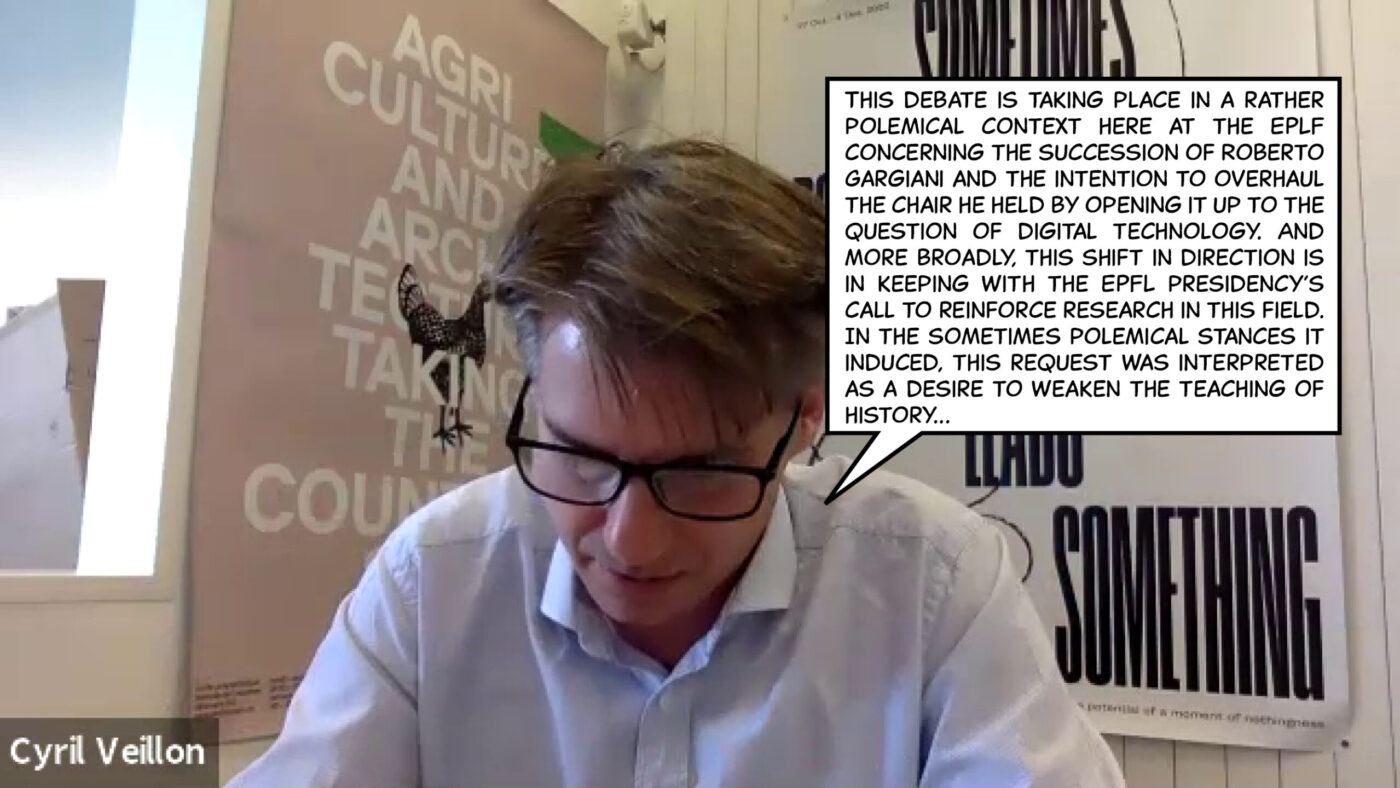
The succession of Roberto Gargiani at EPFL in Lausanne [École polytechnique fédérale de Lausanne] ignited a polemic about the role of history in architecture teaching. From the comfort of their personal environments noted theorists/historians Jean-Louis Cohen, Fabrizio Gallanti, Françoise Fromonot and Philip Ursprung talk about the prospects and relevance of history in architectural education.
This debate is taking place in a rather polemical context here at the EPLF concerning the succession of Roberto Gargiani and the intention to overhaul the chair he held by opening it up to the question of digital technology. And more broadly, this shift in direction is in keeping with the EPFL presidency’s call to reinforce research in this field. In the sometimes polemical stances it induced, this request was interpreted as a desire to weaken the teaching of history. The fact that it came from the president of a technological school only increased tensions. Our debate should not focus on the recruitment process or on the profiles of the people who were initially shortlisted. Rather, we would like to understand with you the current place and state of history in architectural education. And we would like to question the categorical refusal by some people to use the term “digital turn”. To understand what lies behind the stance of defending the architectural discipline. This shift in direction has been described as a “disciplinary coup”. Is this justified? Furthermore, this tense atmosphere is compounded by the concerns of students, who are doubting the relevance of the courses they are participating in, finding them little adapted to the contemporary world. This debate is therefore an invitation to reflect on the disciplinary status of architecture and the interaction between critical theory and history.
We would like to distance ourselves from the polemic in order to better identify the strategic or ideological foundations of the problem. And the first question we could ask Philip Ursprung is what distinguishes the teaching of history between Lausanne and Zurich, EPFL and ETHZ. Can we learn anything from the way the two schools position themselves in this field?
I am a member of the GTA, the Institut für Geschichte und Theorie der Architektur, which was established in Zurich in 1967. At the end of the 1960s, numerous institutes for history and theory were founded, with a common desire to bring about an academic change in the teaching of architecture. The idea was to break away as much as possible from the Beaux-Arts mindset, which was very widespread at the time. It was a turning point that should be seen in the context of the 1968 intellectual revolution. In the case of the GTA, the initial impulse was to have history and theory interact and to provide a platform for reflection on architectural practice. That initial impulse is still relevant today. In the 1990s, the emphasis on critical thinking was attenuated to reinforce the institute’s mission in terms of historical research. The GTA moved away from its original spirit by specialising and reducing the emphasis on contemporary debates. Since I have been at the GTA, that is to say for ten years, I have tried to make it a space for exchange that is accessible to design, urban planners, sociologists and artists. Obviously, not everyone agrees with this approach. The debate about whether we are historians or theorists is still ongoing in our institute. As long as this question remains unresolved, it is a positive sign that our practice is evolving. Four years ago, to celebrate the fiftieth anniversary of the GTA, we organised a conference entitled The End of Theory. One of the conclusions we drew was that theory is alive and well, but that it cannot be clearly distinguished from criticism or history. The other point that came out of this debate was that we are going through a crisis of historicity, which is characterised by a certain amnesia as well as a feeling of the eternal present. This crisis of historicity requires a revision of what we understand by “the history of architecture”, which is one of the causes for the conflict we are currently experiencing at EPFL.
Concerning the difference between the two schools, the EPFL was established in 1968, so shortly after the GTA was founded, and from an engineering school. It’s my understanding that in Lausanne, the intention was never to copy the GTA in its way of merging disciplines, but rather to create specialised chairs in history and theory. The disadvantage of this choice is that in Lausanne you end up with little kingdoms where everyone defends their own territory, whereas in Zurich a group spirit came about in which the “disciplines” were no longer really distinguished from one another. Between Laurent Stadler, who inherited architectural theory, and me holding the chair for the history of art and architecture, there is a loss of respective titles and categories. The precise titles of our chairs do not preoccupy us too much. As for the students, I don’t think they have a clear idea of these issues and what they involve. This institute’s identity is secondary for them.

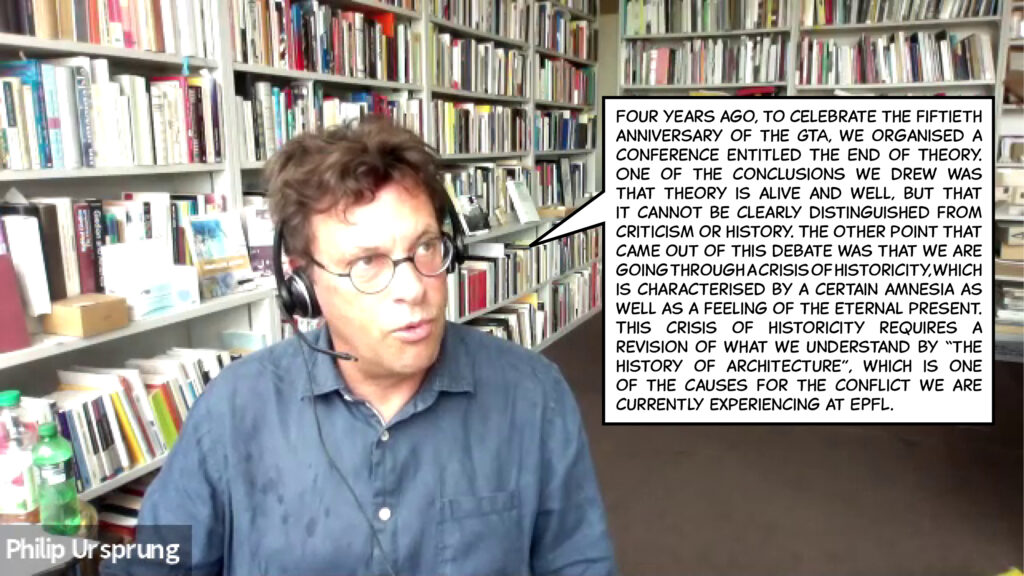
Françoise Fromonot, would you endorse what has just been said, this idea that the practice of history is in some way threatened?
I wouldn’t put it exactly like that, even if I agree in substance with this observation. I should say that I don’t consider myself a historian, even though I have a deep interest in history, which I believe is essential to the practice of criticism. Similarly, I find it difficult to see how architecture can be taught without it. My position would be to defend the teaching of history without adopting a defensive position. In French schools, history is part of the “architectural culture” field, while theory is coupled with “the practice of architectural design” (Théories et pratiques de la conception architecturale et urbaine, TPCAU). I am a professor in TPCAU: I teach theory, in classes and sometimes in studio, and I am also a design studio instructor. I also give some lectures on architectural history, and sometimes I participate in the juries of other studios because I have worked on a particular historical subject. So, the imposed division between fields does not prevent exchanges. But it has to be said that these organic links are forged all too rarely. Greater fluidity would help to make it more natural and relevant for students to use history in their thinking, because this culture is tending to disappear.
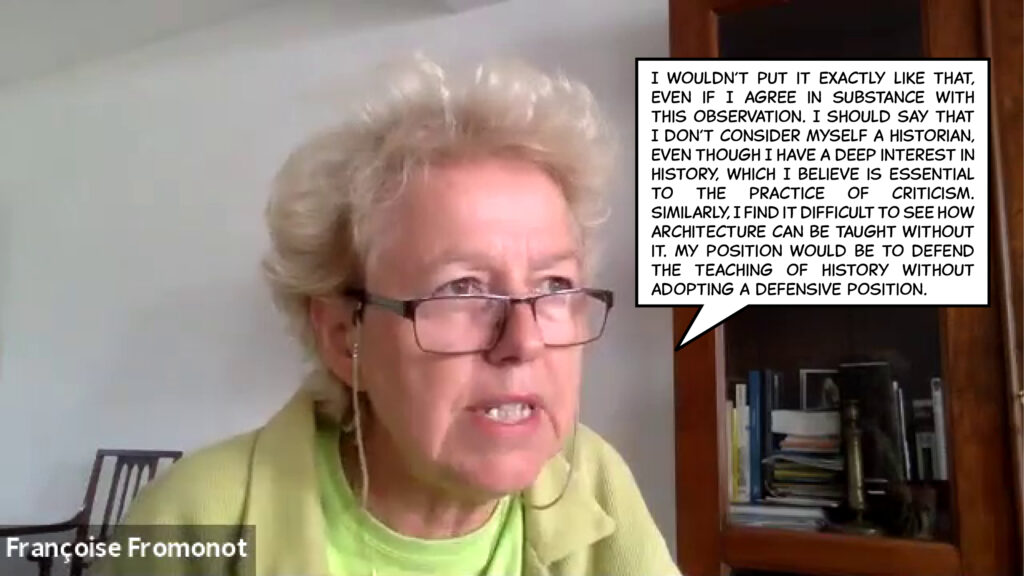
The historian Patrick Boucheron believes that you have those who present history as a national narrative (and who sustain the “energy of the fable”) and the professional historians who deconstruct this narrative, with the two camps speaking at cross purposes. The historian’s job is to write history, and therefore to rewrite it, not to recite it. Is it still possible today to defend a homogeneity of history in architecture, a history that could be considered an edifying narrative, a political lesson? If so, could it be said that history in architecture too often serves to glorify architecture? Or, on the contrary, should history be an art of emancipation, a way of broadening the gaze, of inviting comparisons and connections, even quite distant ones? Is there room for a collective dimension in historical work?
Of course, I share the view, as I imagine we all do here, that history should be a tool of critical knowledge to be constantly re-evaluated, rather than a moral fable to be recited. The distinctions Boucheron makes could almost be transferred by analogy! The advocates of the national narrative he castigates would in this case be the defenders of a strictly internalist history of architecture, or of an immutable conception of theory. They exist. That said, if history is threatened, this threat comes as much from presentism and the permanent movement it implies as from disciplinary or ideological immobilism. For some years now, one has had the sense of a growing inability among many students to understand the relevance and role of historical culture, beyond the analysis of a few canonical references considered useful for their studio project. The idea that people have already thought about questions that concern us today, in other periods, in other contexts, and that these antecedents can help us position ourselves and see our current condition in perspective, all this is tending to lose its obviousness and even its meaning, which was not the case even a few years ago. When I examined reports from students finishing their Bachelor’s degrees at Paris-Belleville last June, I was struck by their indifference to courses in historical or theoretical culture. The idea that some of the themes they are fascinated with today because they are topical – flexibility, economy of means, the rationale behind forms, localism – have a rich genealogy to draw on seems to have literally evaporated. This presentism creates a strange situation. It decrees the uselessness of the past for thinking about the present and feeds on the permanent flow of current events provided by new technologies. At the same time, due to the sense of crisis, particularly the environmental crisis, the outlook towards the future is dissolving. History as a link between these three temporalities is becoming increasingly alien to this generation, which is plagued by a structural uncertainty that has perhaps never had an equivalent on this scale.
Is “cancel culture” an epiphenomenon of this offensive against history that you have just described? Does the activism of the current generation tend to assert that up to now everything has been done wrong, and that a clean slate is required?
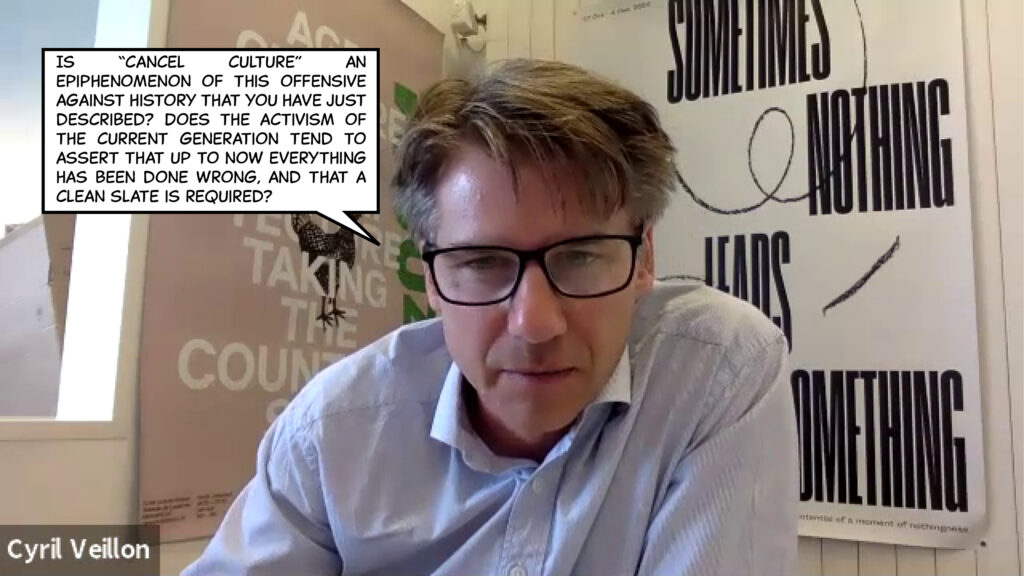
What is referred to as cancel culture does not seem to me to be very present in architecture, at least in France. As I see it, the protests of the most aware and politicised students are primarily to do with the gap between what they are taught and the reality of the world. What often preoccupies them a great deal are the issues of the “out there”, with a palpable anxiety about what role and impact the architect can hope to have.
Without going so far as to completely do away with aspects of the past that are deemed embarrassing, we need to adapt our corpus. There are subjects coming to the fore that cannot be ignored. Others are fading in interest or becoming outdated in the way they were initially formulated… History marches on. A small example: for a long time I taught a contemporary history course in which one session was devoted to the theory of architectural deconstructivism in the 1980s. I showed in particular how the formal research of some of the protagonists of this false movement had been able to flourish thanks to the rise of digital technology. In the current situation, it seems more relevant to me to focus on the effects of IT on everyday architecture – BIM, the increased industrialisation of building components, effects on the construction process, the way offices work, etc. – and on the impact of these changes on the projects themselves.
This type of adaptation of course content strikes me as a fairly healthy evolution of the questions that we can have students think about, linking them to the progression of our own research. It can also result from the discussions that we have between teachers, in a pedagogical framework or elsewhere – to come back belatedly to Cyril’s point about the collective dimension of historical and critical work.
Is the architect who teaches history a historian or does he or she remain first and foremost an architect?
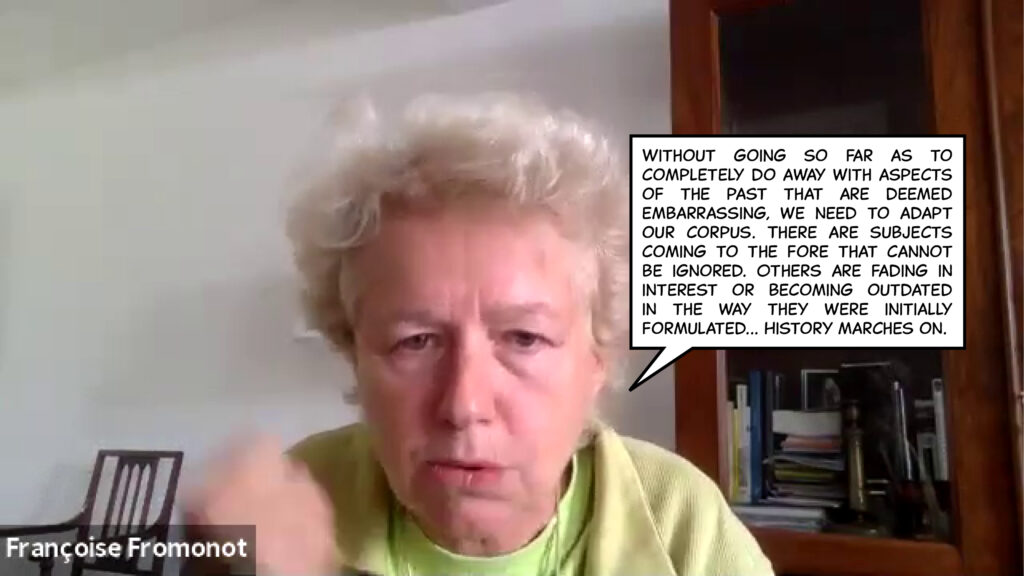
Architects who teach history become historians. We are no longer in the 1950s, when many historical narratives were written by architects who had no such aspiration to be historians. Today, someone who writes a doctorate in architectural history becomes a historian. Moreover, I refute the American definition of architectural historian, which describes a kind of subculture, by appending the historian to the discipline. I think we should rather speak of historians in the strict sense of the word, who operate in or work on architecture.
I would like to say that this triangulation of criticism, theory and history is not only found at the GTA. It can also be found, for example, at MIT with the HTC (History, Theory, Criticism) programme, created by Stanford Anderson in the 1980s. It’s the idea of combining several modes of research. To come back to the episode of the EPFL call for applications, insofar as I understand it, it seems to me to be fairly typical of the approach of engineers, who are generally the promptest to endorse the latest discourse and forget everything else. The idea that a chair of history can be based solely on what has happened in the last twenty-five years is one of those postures doubly marked by impatience and ignorance. Having said that, I agree with what Françoise says about not neglecting a practical theoretical approach to the new division of labour introduced by digitisation, between designer and builder. Without wishing to exaggerate, the situation reminds me of the famous statement by Walter Gropius, who claimed the history of architecture started with the Crystal Palace, with the beginning of industrialisation, without anything that came before having the slightest meaning or utility. So I would say that this phobic attitude has earlier origins. It has its own history.

I think all of us, from the first-year student to the most specialised PhDs, feel that it is necessary to continue surveying the history of architecture. Yet, I feel that the tools and methodologies, the techniques with which history is integrated into teaching are a little outdated. This is not to call into question the need for history to be taught, but to question a relative stagnation of teaching practices. Many of us feel the need for change, but without knowing how to bring it about. I have a little Swiss anecdote on this subject:
Two years ago, the Mendrisio school advertised a position for a professor of criticism and theory, supposedly to focus on contemporary architecture. The University of Ticino had issued a very demanding set of requirements for candidates: dozens of documents to be provided, copies of articles, statements on research and teaching. I was one of the finalists and like all the other finalists I made the trip to Mendrisio, with the school going to all kinds of lengths to prevent the candidates from running into each other. There were seven of us, sometimes travelling from great distances. We had to give a lecture, selected from among three alternatives proposed by each candidate, to a large committee of Swiss and international bigwigs, followed by a very intense interview. There was no feedback for several months, and finally a brief message was sent, stating that the position would not be filled. Later, the word got out that three candidates had been selected by the jury and proposed to the school, but that internal obstacles prevented this choice from being officially recognised. On the one hand, the school created the impression that it was necessary to establish this theoretical chair. On the other, they did not seem to know exactly what to do with it. What was this teaching supposed to cover? Contemporary architecture, criticism perhaps? I think that the very idea that this teacher could focus his research on the architectural production of one of his future colleagues made them backtrack. In my view, this situation is symptomatic of the uncertainty that exists regarding the role of history, criticism and theory in general.
Having said that, I meet more and more young students for whom history no longer has the same role in forming their identity as it has had for generations. This is a paradigm shift that goes far beyond university, and which is evident in the teaching of history from primary school onwards. We have moved from a grand narrative model that is linear, Eurocentric and full of gaps – spanning from the Babylonians to the Second World War – to methodologies of teaching history centred on fragments or projects. From primary school onwards, the focus is on extremely specific episodes, but without the overall vision, chronological or otherwise, which meant that someone studying the Second World War more or less knew that it had been preceded by a First World War. This is the dominant pedagogical framework that architectural history is also confronted with. This fragmentary approach is of course compensated by an access to sources that was unimaginable even fifteen years ago. Today, it merely takes a few clicks online to satisfy any request, giving access to large quantities of archive material. The digitisation of archives is completely changing our relationship to the past. In his book Retromania, the music critic Simon Reynolds very clearly analyses this transition from analogue archives and libraries with space limitations to the seemingly infinite limits of digital platforms. What is lacking is the overarching narrative that will stitch all these specific sequences of knowledge together, and especially the relationships of causality and correlation. This tendency can also be observed in the history of architecture. There are still some professors who adhere to this somewhat antiquated model of grand narratives. A convincing alternative has not yet emerged: what we are seeing more and more is an approach based on the extraction of isolated elements that can be useful for projects, but which are insufficient to establish a real capacity for analysis. Students will be able to study a Le Corbusier project down to the last detail, with the specialist in the subject, and then the next semester move on to Tadao Ando because he provides another professor with the basis for his course.
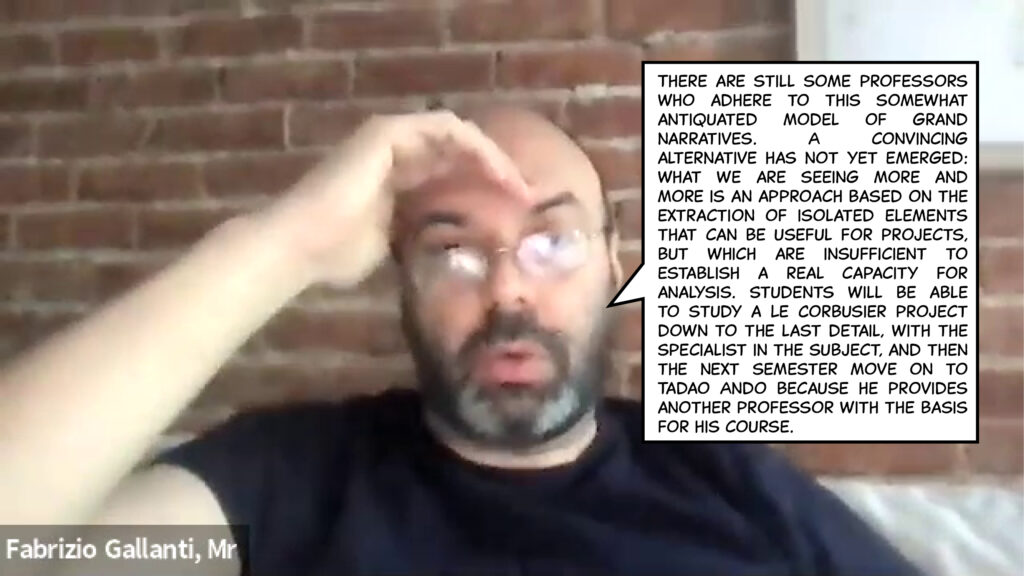
What I think has been lost along the way is political intelligence. There is still a will to act, but the political intelligence is missing. Is this a consequence of the new digital formats of knowledge? Is it a new way of positioning oneself in relation to knowledge as power?
After the fall of state communism, it was mainly in the field of politics that the great narratives came to an end. For the last thirty years or so, political shifts have been associated with micro identities, sometimes opposed to each other. The value of feminist, environmental, gender-related and racial struggles and claims is undeniable. While we cannot fail to show solidarity with these movements, we must recognise that they can sometimes be manipulated and channelled back into conservative movements: in San Francisco, former environmental activists of the American counterculture oppose residential densification, which has been a factor in increasing the supply of social housing for the past thirty years. They are campaigning to preserve organic communal gardens in neighbourhoods that have become unaffordable. Elsewhere, in England, you could say the same of the clumsy attempt by a fraction of the Labour Party to distance itself from an immigrant electorate, identified as Muslim. They do so by brandishing very superficial issues of gender and modernity, in a highly generalised way. Do we need to remind ourselves that this fragmentation is extremely useful to capitalism? As our identities are segmented, it becomes very difficult to find moments that federate people where similarities take precedence over differences. It is a return to the Roman system of divide et impera. This is reflected in the way in which teaching, pedagogies and academic collaborations are established, being quite frequently based on arrangements adapted to particular themes or needs.
Do we have reason to be optimistic and say that it is just established knowledge that is being threatened and that it is merely being replaced by knowledge that is not yet dominant?
Yes, I would be quite optimistic. I agree with you there. One need only think of those who are curious and are challenging the ivory tower of the discipline to explore tangents. As far as cancel culture is concerned, for me it simply does not exist. It’s a spectre that has been conjured up by well-to-do, ageing, white men who are a bit annoyed that they can’t continue to spout their bullshit publicly. I think it’s quite healthy to question the clichés and achievements that we have been bombarded with for thirty years.
To come back to what Françoise was saying about the new generation, let’s not forget that a hundred years ago, another new generation also proposed starting from scratch and no longer teaching architectural history. There is the famous anecdote of the students of the School of Architecture of the Universidad Catolica in Santiago, Chile, in the 1940s, who burned the books of Vignola, the classical architectural treatises that were the basis of the Beaux-Arts-style teaching prevalent in the faculty. After this cathartic act, which had a whiff of an inquisition about it, they left Santiago to go to Valparaiso and open another alternative school where, eventually, modern architecture would be taught. The outraged or annoyed reaction of a 21-year-old student who is now being asked to reread Adolf Loos in fact strikes me as quite healthy.

This is not unrelated to what Alessandro Baricco says in The Barbarians, namely that what we call barbarism today may be the civilisation of tomorrow. The invention of the concept of barbarism is a reaction that runs through many cultures, from China to the West. Herodotus was already interested in it. I would like to ask Jean-Louis about the different approaches to history that he had to deal with when he took up his position at the Cité de l’Architecture et du Patrimoine in Paris. There was a request for national heritage to be promoted, which you interpreted in a much more open and international way. This episode also brings to mind a certain reluctance these days to let canonical history open up to new dimensions and new forms of knowledge.
A page out of my autobiography: when I set up the Cité de l’Architecture et du Patrimoine in Paris, I inherited an institution called the Musée des Monuments Français, which was a reincarnation of the museum of comparative sculpture imagined by Viollet-le-Duc in 1879. Viollet-le-Duc’s intuition was that the “superiority” of French architecture could not be decreed, but that it had to be explained through a cyclical analysis that would oppose it century after century to Italian architecture. His museum therefore had an international comparative dimension, and in the late 1840s he had initiated a comparative project for a European collection of casts, in cooperation with several museums.
When I inaugurated the gallery of modern and contemporary architecture, which was to span the nineteenth to the twentieth century, I did so on a transnational basis. New types of architecture such as skyscrapers had to be included. The idea was not to be satisfied with national paradigms and to look to other countries for what needed to be exhibited to develop this narrative. François de Mazières, the current mayor of Versailles, who replaced me at the time, told me very simply, almost innocently: “Mr Cohen, your museum project was just too cosmopolitan.” This episode gives us cause to rethink the influence of the absolutely stifling tensions surrounding nationalism that persist in many schools of architecture, history or art history departments. It’s less the case in certain countries whose national complex is more about inferiority than superiority. I’m thinking of Italy, where there has been a great deal of critical openness since the 1920s. For example, in the work of Edoardo Persico and some others. This national question is far from resolved. In all modesty, I consider myself quite close to what Patrick Boucheron proposes with his world history of France.
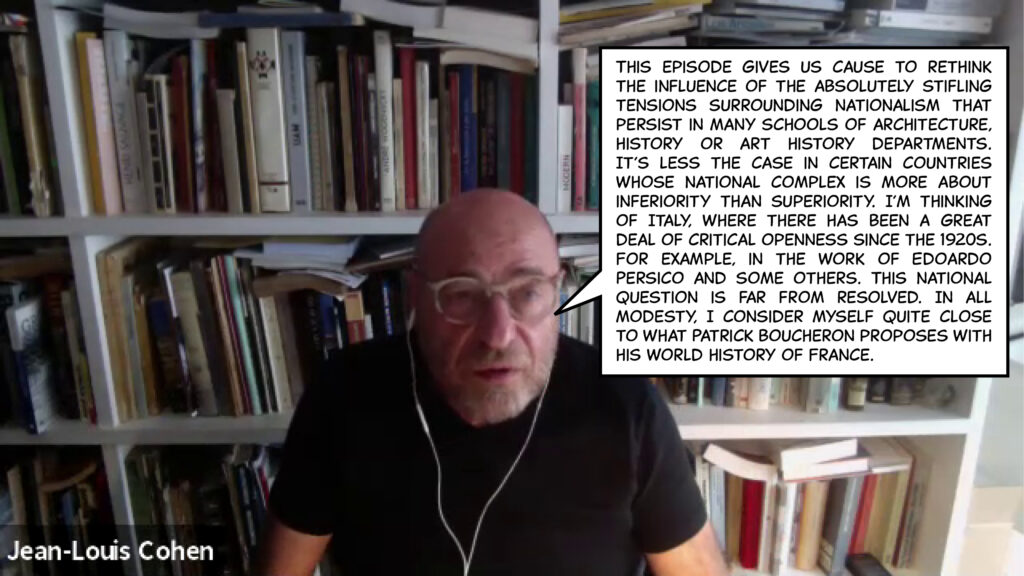
I’d like to ask Philip if he sees the new environmental sensibility an evolution of the Marxist political sensibility that prevailed for much of the twentieth century? Is there a new political paradigm emerging in relation to the ecology?
If you wish to measure this change in terms of students’ energy and concerns, it is undeniable. As soon as you begin a discussion on the Anthropocene, with authors such as Anna Tsing, there is immediately a great deal of interest. These are subjects they want to know more about. And they are much more interested in observing the environment in the landscape sense than in comparing city centres. The concept of the urban as a succession of skylines has given way to an interest in the landscape, the environment or the relationship between the human and the non-human. In the last five years, anthropology and ethnology have been given a new lease of life precisely because they integrate a wide range of factors. A new paradigm is emerging, and we should in no way oppose it. Reducing architecture to what has been built in brick and concrete is no longer acceptable. The tendency to build walls around disciplines is counterproductive. Opportunities must be created to learn from what is happening in other fields in order to enrich the architectural discourse. It is a positive sign that students are challenging the canons and our teaching, after a long and rather apolitical period when they were content to consume whatever they were given.

On this question, it may be useful to go back to Jean Piaget, and his very beautiful concept of assimilation. I think that the challenge for the teaching of history in architecture is not to mimic other disciplines on the environmental question, but to assimilate their cognitive practices, that is to say to appropriate them while transforming them. This is something that has been done several times, if we think of structuralism and the integration of structural and technical issues in the 1960s and 1970s.
Perhaps it is a lucky thing for us have a concerned generation with a creative appetite for all these challenges. With the climate crisis, the energy crisis, the geopolitical crisis, etc. and the new challenges they force us to consider, architecture schools may have the opportunity to become intellectual and project-based laboratories again. Not only at the level of formal research, postgraduate and doctoral studies, but throughout the curriculum. After all, this was somewhat the case in the 1970s with the crisis of modernism and the return to the city.
The worst thing would be to fall back into the startled attitude that has prevailed over the last thirty years towards globalisation, admired or criticised for the new forms it produced to the detriment of a productive reading of its programmatic implications. Could schools regain the upper hand by engaging, through architecture, in the search for alternative, concrete and theoretical proposals, without neglecting the mediations that would allow these proposals to have an impact on the profession, the decision-makers, and, more broadly, on society? It would be a real pity if the role of the school was limited to perpetuating the technico-industrial doxa that dominates today.
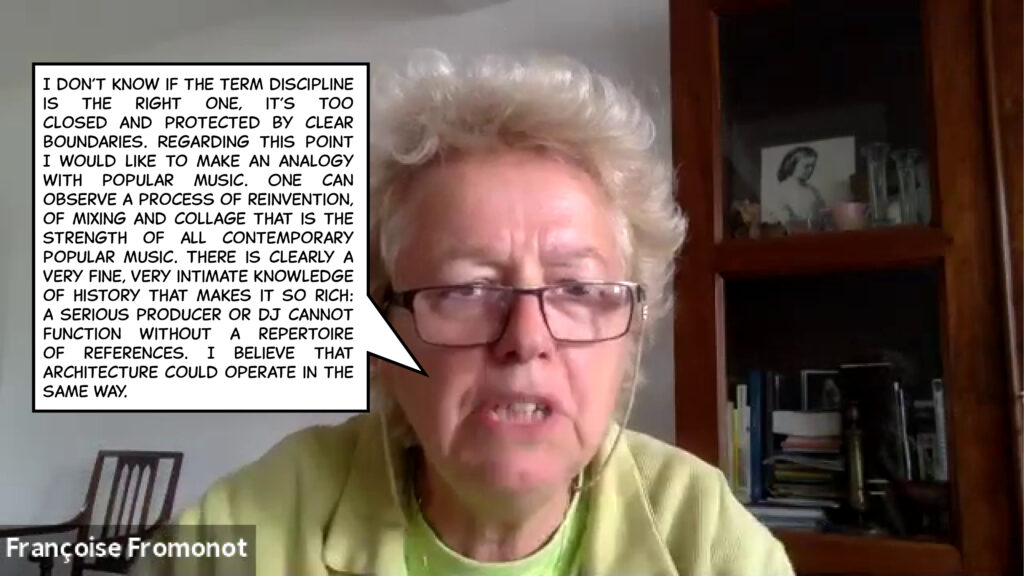
I totally agree. To go back to the case of Lausanne, the digital turn is too important to leave it to the engineers alone. Architectural theory absolutely has the right or even the duty to get involved in this discussion, to be part of it and to shape it.
Shouldn’t we ask ourselves what kind of architectural historians universities produce? This is a question I put to Philip, Françoise and Jean-Louis. Shouldn’t we also review the doctoral models, the organisation by departments? If we had more people like Reyner Banham, I think the job would be much easier, especially in terms possibilities for moving between various disciplinary fields and activities; writing, also for larger audiences, curating and research. The mechanisms for perpetuating academic positions in schools generate a hyperspecialisation which produces a type of teacher who is brilliant, intelligent, but whose writing will not be read by more than twenty-five people. If we think that we need to reform the way the design project is taught to make architects evolve, shouldn’t we start with those who produce knowledge? I have the impression that our schools are far from what we need them to be. In the end, what kind of intellectual and historian should we cultivate and promote?
Absolutely. Having said that, again, the rise of environmental issues will perhaps encourage this interdisciplinary circulation and this influx of new content. By definition, these subjects have the potential to reconfigure teaching methodologies, since they simultaneously engage multiple fields and competences, and intensely so. Architecture is by definition well placed to take the lead in such multidisciplinary experiments.
The model of the solitary master lecturing from on-high seems to me quite obsolete, regardless of the quality of the teacher. A forward-looking approach to teaching would require schools to form teams capable of generating projects of all kinds that draw of different types of investigative knowledge – but while avoiding the would-be virtuous practice of establishing specialists or “consultant” teachers, modelled on what happens in the professional life of architects. We have found in our studios that in two or three weeks of very intensive historical and technical research, and with the right people, a small group of students can become knowledgeable experts on a subject that is sometimes far removed from strict architectural issues.
For a somewhat fantasised model of a “total hybrid” teaching methodology one might look to the one instituted by Ian McHarg in the late 1950s at Penn, after he had taken over and reformed the landscape department. His seminar was a sort of open table featuring almost daily contributions by botanists or writers, historians or geologists, biologists or urban planners… We could be inspired by this fine example to teach differently, going beyond compartmentalisation and specialisation.
A lot of work is emerging on the articulation between the environment and architecture. Apart from that, it’s true that the dominant discourse in North America shows a pronounced interest in research on the mediatisation of architecture. We’re coming out of a twenty-year period that was marked by an overload of research on books, exhibitions, exhibitions of books, exhibition books, sometimes with intelligent, imaginative studies, but which are beginning to be wearying because of their very postmodern framing devices. I think that today we are seeing the outlines of other discourses emerge, such as, for example, all these works that look at the non-European in terms of history and architecture. In my view it would be interesting to freshen up the hypotheses by taking note of this new thematic geography. What if environmental and digital issues were taken seriously, but without discarding everything else? This would be a positive way to respond to the institutional hiccup of Lausanne’s failed recruitment.
At this point, I would just like to defend the doctoral thesis that is not read by anyone, because I deeply believe in this model of academic freedom that gives researchers the choice to decide for themselves the subject they will spend three years on, regardless of whether they will be read or not. This independence is a strength, which allows researchers to go on to do exhibitions, write critical texts, and navigate between different fields of knowledge. What must be avoided at all costs is the system of exclusive domains. We mustn’t let people only reproduce their own values and use the means provided to them just to build walls. This autocratic way of delimiting fields of knowledge must be put to an end.
We would like to close this debate by asking a final question about whether architecture needs some form of mediation. Indeed, is there an “architectural discipline” to be defended?
I don’t know if the term discipline is the right one, it’s too closed and protected by clear boundaries. Regarding this point I would like to make an analogy with popular music. One can observe a process of reinvention, of mixing and collage that is the strength of all contemporary popular music. There is clearly a very fine, very intimate knowledge of history that makes it so rich: a serious producer or DJ cannot function without a repertoire of references. I believe that architecture could operate in the same way. There is still an interest in history on the part of students, even if it is no longer articulated in the same way. It is up to us to respond to this desire by reinventing the tools to bring to the fore a more mobile, dynamic and critical history. In this sense, I think that we are also in a very stimulating period. When students tell us that they are tired of hearing about the same authors, it is up to us to go and find different ones.
Concerning buildings that speak for themselves, there has been a fashion in schools for a while now for forms that express themselves by their very presence, as emanations of the very essence of architecture and its fundamentals. Therefore requiring no explanation or justification. This, perhaps, is what represents the “disciplinary” attitude in the narrowest and most rigid sense of the term. What history teaches us, on the contrary, is that forms are charged with the discourses that have constituted them over the course of circumstances and contexts as relevant, recognisable and, ultimately, shared. These discourses may have been competing or contradictory, and some have been supplanted by others, for multiple reasons that require analysis.
Rather than withdrawing into an illusory security or allowing itself to be sacrificed on the altar of efficiency, the teaching of history could take better advantage of this complexity, dare to confront marginal questions, exhuming authors left in the shadows, multiplying points of view, destabilising students’ preconceived ideas in order to familiarise them with argumentation. What architecture needs more than ever, in my opinion, is a history that is viewed critically, a history that is agile, but above all untranquil, and why not polemical.
The term discipline also bothers me a little. Are we talking about an architectural culture that is supposed to integrate everything that comes from the practice of the project, but also its conceptual, written, visual and other environments? It’s a highly charged term due to the way it was used by someone like Zevi, who had a very instrumental conception of history. So all terms are slippery.
The important thing is to bring to light the historicity of knowledge, techniques and procedures. And I think that this is one of the things that we have to make students understand. This is what is completely missing in most engineering schools. Some of them have an awareness of the history of the fields of technology, but many of them operate in the immediacy of the present and the certainty that there is no reason to look back. In contrast, architects have always been tempted to look in the rear-view mirror, if only to legitimise new forms. How can we ensure that in teaching, architecture produces both contemporary and forward-looking knowledge, while at the same time inserting it with a certain precision in the field of history?
The idea that architecture speaks for itself is like imagining that art does not need to be exhibited. It’s like thinking that fish don’t need water. It doesn’t really make sense.
I’d like to come back to Jean-Louis’s observation about what engineering is lacking today. I know this from experience, having witnessed the erosion of engineering’s ability to talk about what it does. Engineering is not just losing its critical faculty. It is losing the ability to speak altogether. Engineering’s ability to generate a discourse, even a descriptive one, has been in constant decline. From being dominant a century ago, this ability has gradually disappeared. And digitisation has a lot to do with it. Today, it is no easy matter to find contributors capable of writing about the engineering of our time. It is a field of knowledge that has completely disappeared. So maybe by reinventing it, we could also contribute to the intelligence and understanding of what is happening to us on a media level.
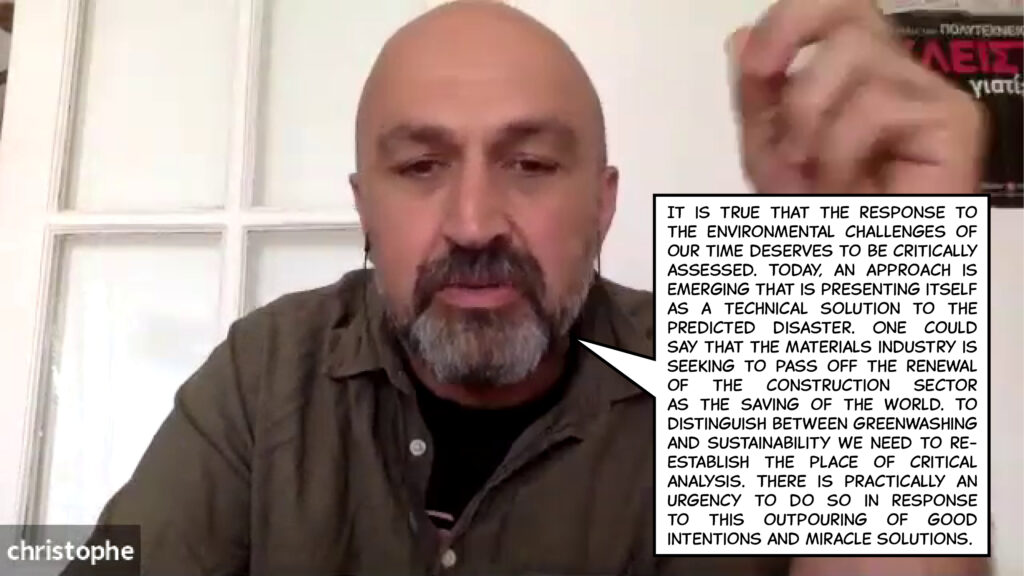
Not to mention that in relation to many issues today – materials, resources, energy, etc. – engineers of all kinds are really taking over. A critique of engineering by architecture is also necessary for this reason, drawing on history and theory in a new way.
It is true that the response to the environmental challenges of our time deserves to be critically assessed. Today, an approach is emerging that is presenting itself as a technical solution to the predicted disaster. One could say that the materials industry is seeking to pass off the renewal of the construction sector as the saving of the world. To distinguish between greenwashing and sustainability we need to re-establish the place of critical analysis. There is practically an urgency to do so in response to this outpouring of good intentions and miracle solutions.